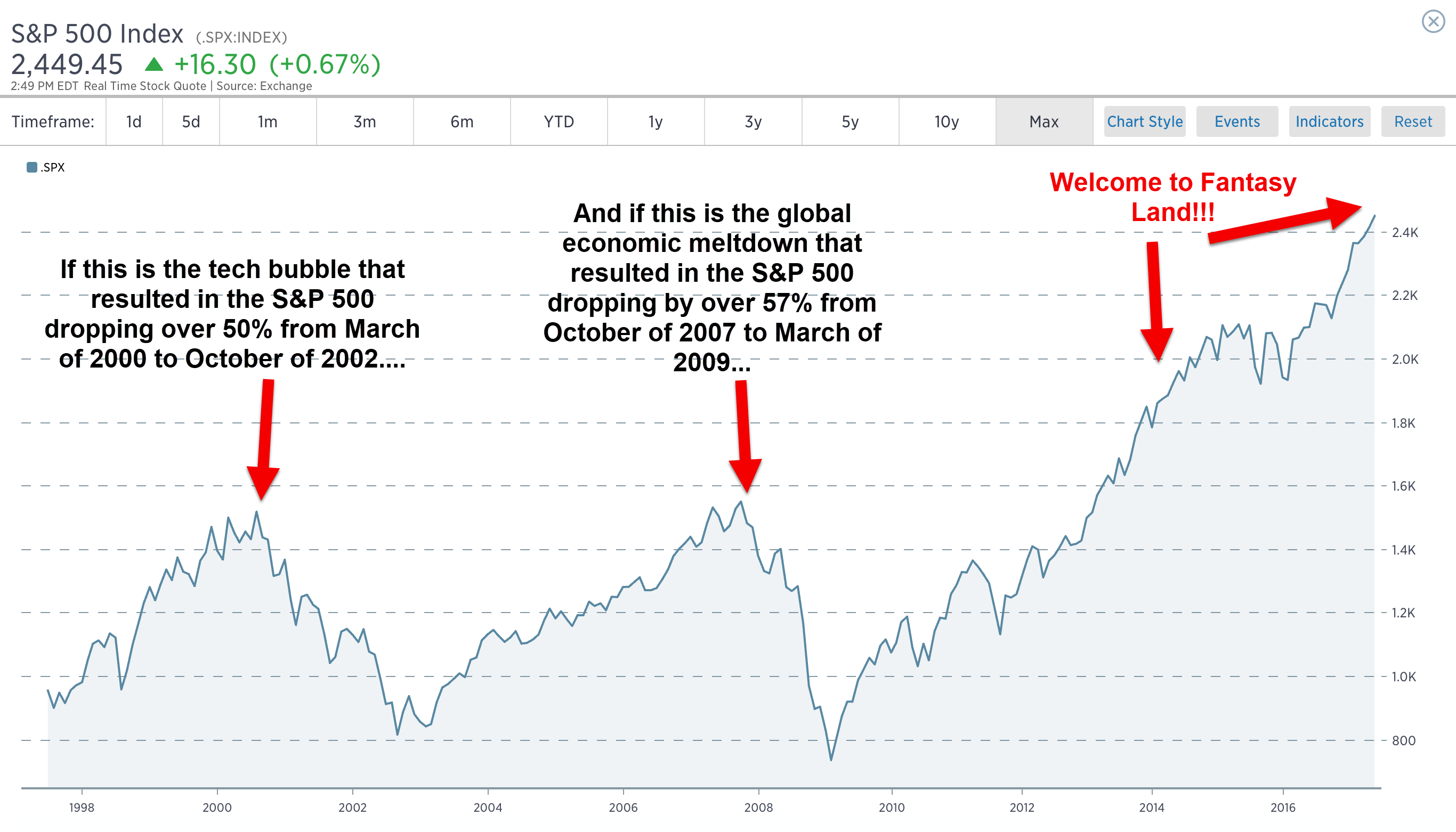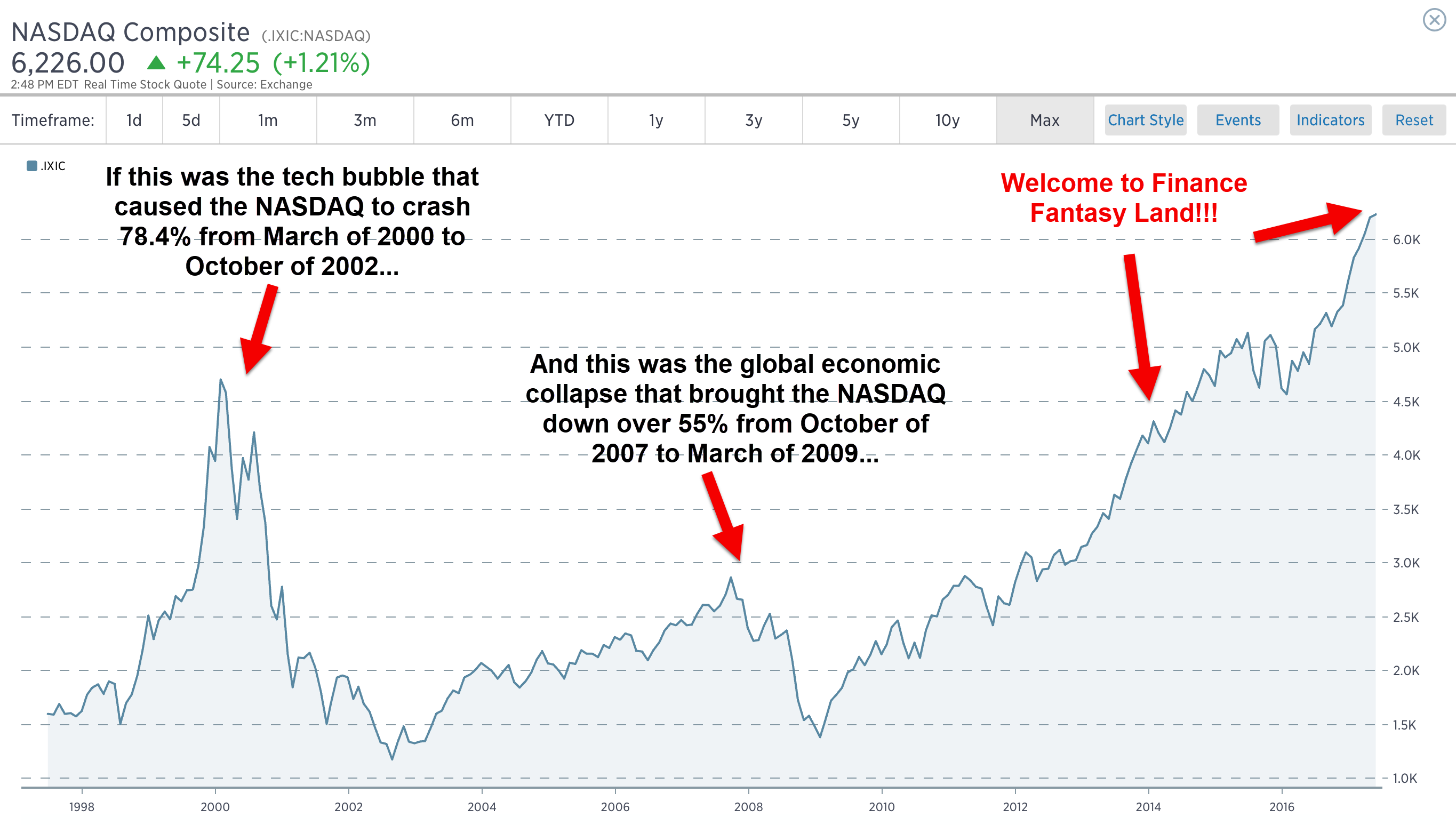
Posted June 25, 2017
Finance Fantasy Land sounds like a wonderful place. It’s a land where interest rates are so low that you can borrow gobs of money that would be undoable in any other place. It’s a land where the governments and central bankers pump trillions of dollars into the system to give the appearance that all is super-duper in the economy. It’s a land where everybody can drive nice cars, live in big homes, wear fine clothing, and buy whatever their little heart desires. It’s a place where stock prices just keep going up, even if the revenues, earnings, and cash flows are stuck in the mud.
As long as everybody can just keep borrowing more and more money, Finance Fantasy Land is the place to be.
Finance Fantasy Land is Utopia…until it’s not. It always just turns out to be a temporary illusion. There are never free lunches in economics.
We’ve visited Finance Fantasy Land many times in the past. The two most recent vacations to Fantasy Land were the Tech Bubble that ended in 2001 and the global economic meltdown that started in the Fall of 2007. There were additional vacations to Finance Fantasy Land over the past 110 years.
It’s often fun to look at old photos from prior vacations and reminisce about the good times and fond memories.
Here’s a past photo when the S&P 500 took a few vacations to Finance Fantasy Land over the past 20 years.

For all of you NASDAQ and technology lovers who want to reminisce, here’s another good one from past vacations in Fantasy Land.

If only Fantasy Land was a real place with permanent potential, life would be great.
The reality is, corporate profits (earnings) have only grown about 10% over the past 5 years since 2011. Those increased profits have come because of corporations squeezing margins, laying off higher paid workers, and outsourcing overseas. The economy today can’t even seem to grow at the Fed’s 2% target. Long-term interest rates continue to drop. Long-term interest rates are normally a predictor of future growth and inflation potential in the economy. So, while the stock market is partying like it’s 1999 (pun intended), the bond market is saying the economy is likely to be unimpressive for quite some time.
But in Finance Fantasy Land bad data and economic problems don’t matter. Nor does massive debt levels that will soon become crushing. Rather, investors will just continue to chase yield while completely ignoring price and valuations. We’ve seen this story before and it doesn’t have a successful conclusion for investors who ignore price and valuations.
The one thing we really learn from history is that humans usually completely ignore history.
The Dangers of Buying And Holding During High Valuations
If you are an investor who is buying or holding large amounts of equities during times of extreme market valuations, you are basically saying that price does not matter at all in investing. But what you should know is that eventually PRICE ALWAYS MATTERS.
Now a comment that is made very often by investors is, “But if I am too conservative for a period of time during market extremes and generate a low return, I can’t/won’t meet my goals. Plus, everybody else is making easy money while I’m missing out.” But this mindset is assuming that markets will stay at extreme valuations forever and ever. The question you need to ask yourself is this;
“If you don’t think you will reach your goals while temporarily earning a low rate of return to protect yourself during market extremes, how do you really believe you will reach your long-term goals if you watch your capital base diminish 40%, 50%, 60% or more?”
We have only been in extreme conditions like this a handful of times in market history and they all ended terribly with very large investor losses for those taking on that investment risk. Ask yourself what would happen to your retirement plans if you lost 50% or even more than 70% of your capital base? Could you hang on and recover from such a loss?
The value of having a trusted advisor on your side is that they can help guide you during these times. We are here to help you navigate what should be very challenging market conditions during the second half of the market cycle. And here is the good news…For those wise investors who pay attention to price and value and protect their capital during bouts of extreme valuations, they are best positioned to take advantage of lower prices and better values once market conditions reset to historical norms.
The key to successful investing is to buy quality investments at fair prices (or better yet – attractive prices.) If the price isn’t right, you should have the fortitude to simply not buy and wait for better prices to come along in the future.
What would it feel like to boost your wealth significantly over the coming decade? Avoiding high-risk investment conditions is one of the best tactics and strategies available to make that happen.
